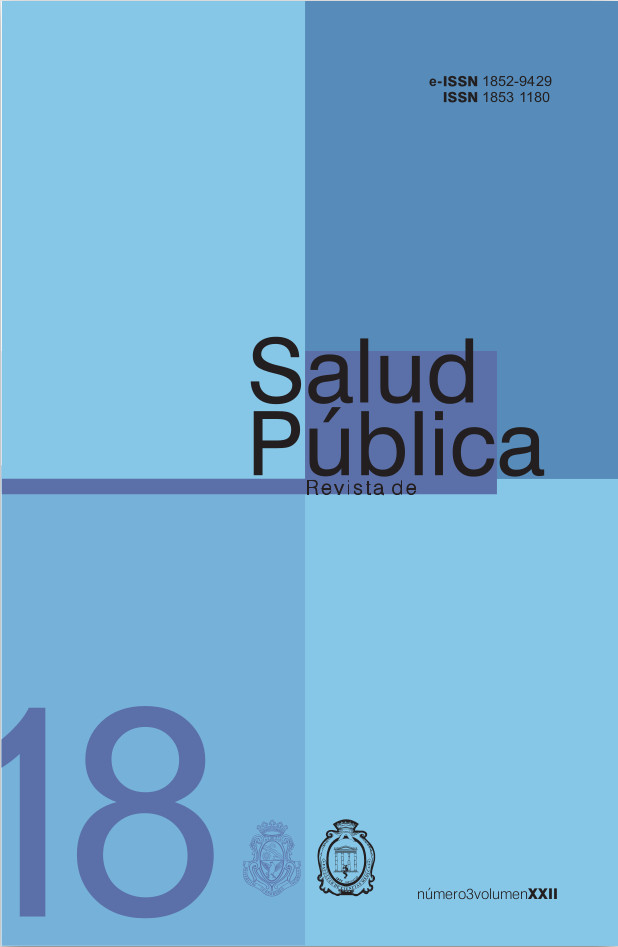CLEANNESS AND SANITARY CONDITIONS OF THE TOWN OF CAPARRAPI- COLOMBIA AND THE APPEARANCE OF ACUTE DIARRHEAL DISEASE IN THE POPULATION BETWEEN 0 AND 15 YEARS OLD
DOI:
https://doi.org/10.31052/1853.1180.v22.n3.20385Keywords:
Environmental health, sanitary conditions, diarrheaAbstract
This study identified the cleanness and sanitary conditions of the town and the appearance of gastrointestinal diseases in the population between 0 and 15 years old. A cross sectional quantitative descriptive study was done; a survey was applied in 90 homes and Chi Square Statistics and Odds ratio were used to determine the relationship of variables with the appearance of diarrhea in the population between 0 and 15 years old. Three hundred forty
nine people live in the homes where the survey was applied; 116 (33%) are between 0-15 years old; 66 cases of Acute Diarrheal Disease (ADD) were reported and 66.7 % of them correspond to the population aged 0-15. The presence of municipal cleaning service, location of the storage tank, location of the kitchen within the home, sink separated from other areas and disposition of excreta were the variables statistically related with the appearance or diarrhea in this population.
Downloads
References
1. Organización Mundial de la Salud. Cada año mueren 12,6 millones de personas a causa de la insalubridad del medio ambiente. Comunicado de prensa. 2016. Disponible en: http://www.who.int/mediacentre/news/releases/2016/deaths-attributable-to-unhealthy-environments/es/
2. Pruss Ustun . A & Corvanlán, C. (2006). Preventing disease through healthy environments. Organización Mundial de la Salud: Disponible en: http://www.who.int/quantifying_ehimpacts/publications/preventingdisease.pdf
3. Instituto Nacional de Salud, Colombia. Informe de evento Mortalidad por EDA en menores de 5 años. 2012. Disponible en http://www.ins.gov.co/lineas-de-accion/Subdireccion-Vigilancia/Informe%20de%20Evento%20Epidemiolgico/EDA%202012.pdf
4. Cáceres, D. C., Izquierdo, V. F., Mantilla, L., Jara, J., & Velandia, M. Perfil epidemiológico de la población desplazada por el conflicto armado interno del país en un barrio de Cartagena, Colombia, 2000. Biomédica, 2002; 22:425-44.
5. Vázquez de Plata, G. E., Gómez de Avellaneda, E., & Gamboa Delgado, E. M. Condiciones higiénico sanitarias de los servicios de alimentación en instituciones infantiles del Instituto Colombiano de Bienestar Familiar de Bucaramanga, Colombia. Revista Cubana de Alimentación y Nutrición. 2007; 17(1):23-33.
6. Alcaldía Municipal de Caparrapí. Plan de Desarrollo Municipal. Caparrapí.2012.
7. Municipio de Caparrapí. Plan Territorial de Salud 2008-2011. Caparrapí. 2008.
8. Organización Panamericana de la Salud/Organización Mundial de la Salud OPS/OMS. Representación en Colombia. (2010). Manual educativo Nacional. Hacia una vivienda saludable. Disponible en: http://www.paho.org/COL/index.php?option=com_content&view=article&id=954:manual-educativo-nacional-hacia-una-vivienda-saludable-que-viva-mi hogar&catid=681&Itemid=361
9. Pereira, VV, Tibúrcio, DJ, Alves, SN & da Silva, ES . Avaliação de parasitoses intestinais, estado nutricional e Indicadores sociais em alunos de quatro escolas do ensino fundamental público da cidade de Divinópolis -Minas Gerais-Brasil. Neotropical Helminthology, 2010; 4:149-157.
10. Organización Mundial de la Salud. Lucha contra las enfermedades transmitidas por el agua en los hogares. 2007. Disponible en : http://www.who.int/household_water/advocacy/combating_disease_es.pdf
11. Organización Panamericana de la Salud. La salud en las Américas. Vo I. Publicación Científica y Técnica No. 587.2002. Disponible en: http://www.paho.org/hq/index.php?option=com_docman&task=doc_view&gid=16931&Itemid=
12. Gardilcic F, Magdalena, Fica C, Alberto, Chang R, Mayling, Llanos M, Carolina, & Luzoro V, Amaranta.Diarrea asociada a Clostridium difficile en un hospital de adultos.: Estudio descriptivo. Revista chilena de infectología. 2000;17(4): 307-312.
13. Londoño, Ángela L. Mejía Shirley y Jorge E. Gómez-Marín. Prevalencia y Factores de Riesgo Asociados a Parasitismo Intestinal en Preescolares de Zona Urbana en Calarcá. Revista De Salud Pública. 2009;11 (1): 72-81.
14. Valiente C, & Mora, D. El papel del agua para consumo humano en los brotes de diarrea reportados en el período 1999 - 2001 en Costa Rica. Revista Costarricense de Salud Pública. 2002; 11(20): 26-40.
15. Díaz Delgado Carlos. Agua potable para comunidades rurales, reusó y tratamientos avanzados de aguas residuales domésticas. Red Iberoamericana de Potabilización y Depuración del Agua. RIPDA-CYTED, Capítulo 13, Riesgo de enfermedades transmitidas por el agua en zonas rurales p 156. 2003.
16. Ros, C et al. Análisis de factores socio-culturales y ambientales involucrados en problemas de salud prevenibles (diarrea, malnutrición y anemia) en niños de 0 a 4 años en la comunidad de la Zona Sur de Gualeguaychú. Implementación y evaluación de intervenciones. Ciencia, Docencia y Tecnología Suplemento. 2016; 6(6): 122-137.
17. Hernández, L, et al. Calidad del agua para consumo humano y salud: dos estudios de caso en Costa Rica. Revista Costarricense de Salud Pública. 2011; 20: 21-26.
Downloads
Published
Issue
Section
License
Copyright (c) 2018 Escuela de Salud Pública y Ambiente. Facultad de Ciencias Médicas. Universidad Nacional de Córdoba

This work is licensed under a Creative Commons Attribution-NonCommercial 4.0 International License.
Authors who publish with this journal agree to the following terms:
- Authors retain copyright and grant the journal right of first publication with the work simultaneously licensed under a Creative Commons Attribution License which allows the work to be copied, distributed, exhibited and interpreted as long as it is not done for commercial purposes.
- Authors are able to enter into separate, additional contractual arrangements for the non-exclusive distribution of the journal's published version of the work (e.g., post it to an institutional repository or publish it in a book), with an acknowledgement of its initial publication in this journal.
- Authors are permitted and encouraged to post their work online (e.g., in institutional repositories or on their website) after the publication process. (See The Effect of Open Access). (See The Effect of Open Access).







